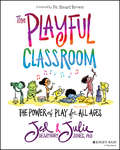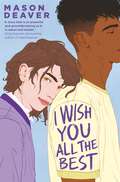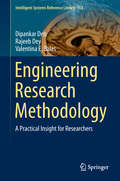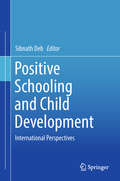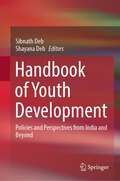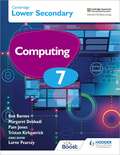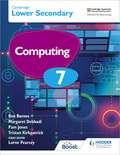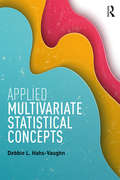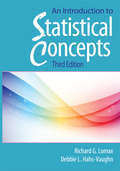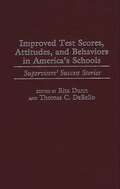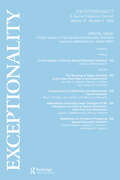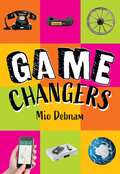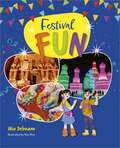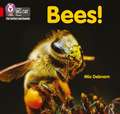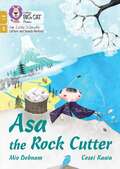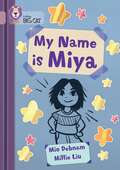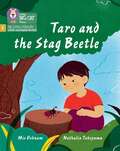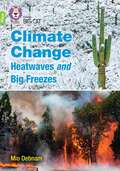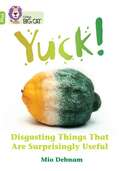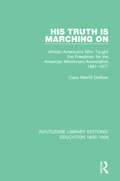- Table View
- List View
The Playful Classroom: The Power of Play for All Ages
by Jed Dearybury Julie P. JonesShows teachers how and why they should bring play into the classroom to make learning meaningful, relevant, and fun. Research studies show that all students—young and old, rich and poor, urban and rural—benefit immensely from classrooms filled with art, creativity, and laughter. Fun, playfulness, creative thinking, and individual expression reinforce positive experiences, which in turn lead to more engaged students, better classroom environments, and successful learning outcomes. Designed for K-12 educators, The Playful Classroom describes how teachers can develop a playful mindset for giving students meaningful, relevant and fun learning experiences. This unique real-world guide provides you with everything you need to incorporate engaging, hands-on lessons and creative activities, regardless of the level and subject you teach. Building on contemporary and seminal works on learning theory and play pedagogy, the authors explain how to inspire your students by bringing play. into your classroom. This clear, user-friendly guide supplies practical strategies and effective solutions for adding the missing ingredients to your classroom culture. Access to the authors’ companion website provides videos, learning experiences, and downloadable teaching and learning resources. Packed with relatable humor, proven methods, and valuable insights, this book enables you to: Provide meaningful experiences that will benefit students both in school and later in life Combine the principles of PLAY with traditional curricula to encourage creative learning Promote trust, collaboration, and growth in students Develop a playful mindset for bringing the arts into every lesson Foster critical thinking in any school community The Playful Classroom: The Power of Play for All Ages is a must-have resource for K-12 educators, higher education professionals, and readers looking for education-based professional development and training resources.
The Playful Classroom: The Power of Play for All Ages
by Jed Dearybury Julie P. JonesShows teachers how and why they should bring play into the classroom to make learning meaningful, relevant, and fun. Research studies show that all students—young and old, rich and poor, urban and rural—benefit immensely from classrooms filled with art, creativity, and laughter. Fun, playfulness, creative thinking, and individual expression reinforce positive experiences, which in turn lead to more engaged students, better classroom environments, and successful learning outcomes. Designed for K-12 educators, The Playful Classroom describes how teachers can develop a playful mindset for giving students meaningful, relevant and fun learning experiences. This unique real-world guide provides you with everything you need to incorporate engaging, hands-on lessons and creative activities, regardless of the level and subject you teach. Building on contemporary and seminal works on learning theory and play pedagogy, the authors explain how to inspire your students by bringing play. into your classroom. This clear, user-friendly guide supplies practical strategies and effective solutions for adding the missing ingredients to your classroom culture. Access to the authors’ companion website provides videos, learning experiences, and downloadable teaching and learning resources. Packed with relatable humor, proven methods, and valuable insights, this book enables you to: Provide meaningful experiences that will benefit students both in school and later in life Combine the principles of PLAY with traditional curricula to encourage creative learning Promote trust, collaboration, and growth in students Develop a playful mindset for bringing the arts into every lesson Foster critical thinking in any school community The Playful Classroom: The Power of Play for All Ages is a must-have resource for K-12 educators, higher education professionals, and readers looking for education-based professional development and training resources.
I Wish You All the Best
by Mason Deaver'A soft, sweet, and incredibly important story about a nonbinary teen finding their voice. This book is going to be so important to so many people.' - Alice Oseman, author of HeartstopperIt's just three words: I am nonbinary. But that's all it takes to change everything.When Ben De Backer comes out as nonbinary, it doesn’t go down as planned: they are thrown out of their house and forced to move in with their estranged older sister.All Ben can do is try to keep a low profile in a new school. But Ben’s attempts to go unnoticed are thwarted when Nathan Allan, a funny and charismatic student, decides to take Ben under his wing.As Ben and Nathan’s friendship grows, their feelings begin to change, and what started as a disastrous turn of events looks like it might just be a chance to start a happier, new life.At turns heartbreaking and joyous, I Wish You All the Best by Mason Deaver is both a celebration of life, friendship, and love, and a shining example of hope in the face of adversity.'Heartfelt, romantic, and quietly groundbreaking. This book will save lives.' - Becky Albertalli, New York Times bestselling author of Simon vs. the Homo Sapiens Agenda
Engineering Research Methodology: A Practical Insight For Researchers (Intelligent Systems Reference Library #153)
by Dipankar Deb Rajeeb Dey Valentina E. BalasThe book covers all the important aspects of research methodology, and addresses the specific requirements of engineering students, such as methods and tools, in detail. It also discusses effective research in engineering today, which requires the ability to undertake literature reviews utilizing different online databases, to attribute credit for any prior work mentioned, to respect intellectual property rights while simultaneously maintaining ethics in research, and much more. Further, the book also considers soft skills like research management and planning, dealing with criticism in research and presentation skills, which are all equally important and need to include in research methodology education. Lastly, it provides the technical knowhow needed to file patents in academia, an important area that is often ignored in research methodology books. The book is a particularly valuable resource for PhD students in India and South East Asia, as research methodology is a part of their coursework.
Positive Schooling and Child Development: International Perspectives
by Sibnath DebThis volume discusses the importance of positive schooling in producing responsible and potentially productive adults. Students are generally more motivated to do well and to realize their full potential in schools that have a positive schooling climate, where they feel safe, included and supported. Nevertheless, the reality in today's schools is very different. This volume discusses the major challenges faced by children and adolescents in schools, including problems with curricula, safety issues, lack of inclusive policies, non-availability of teachers, ineffective teaching, insensitivity towards students’ issues, improper evaluation methods, harmful disciplinary measures, and so on. Experts in child psychology and education discuss these issues at length in this volume and offer viable solutions for policymakers, school administrators, teachers and parents to make suitable changes and create a positive atmosphere in educational institutions. This volume further discusses the role of various stakeholders---school principals, teachers, counsellors and psychologists---in addressing these challenges. In addition, it raises other, emerging issues which have not been covered in previous volumes on this topic and offers evidence-based suggestions to address them. The intended readership of the volume is researchers and students of psychology, education, sociology, social work and public health, and school teachers, administrators and teacher-trainers.
Handbook of Youth Development: Policies and Perspectives from India and Beyond
by Sibnath Deb Shayana DebThis handbook provides a comprehensive overview of youth development, including theories and applications across different countries, namely India, the UK, and Australia. It presents the status of youth and their role in society, their education, and their career perspectives. The focus is on developing youth's internal abilities by providing a creative and supportive environment through appropriate mentorship and encouragement. It discusses a wide range of contemporary and relevant issues relating to holistic career growth of youth, whereby youth work is recognized as a profession. Academicians from various disciplinary backgrounds offer conceptual and methodological perspectives. Chapters into five themes focus on a balance between developing stable, protective factors for mental health, and positive youth development to ensure appropriate cognitive, social, emotional, and behavioral skills needed to thrive in an evolving world. It discusses the status of the youth in terms of digital competency, engagement of youth in sports, teaching, political process, and community development activities in the present and rapidly altering world scenario. The book also discusses the role of institution-based family counseling for healthy youth development. Given its comprehensive coverage, the handbook is an essential resource for a broad audience of youth researchers, practitioners and policymakers of population sciences, childhood and youth studies, development studies, and psychology.
Cambridge Lower Secondary Computing 7 Student's Book
by Margaret Debbadi Ben Barnes Pam Jones Tristan KirkpatrickThis title is has been endorsed by Cambridge Assessment International Education Deliver an exciting computing course for ages 11-14, building on students' existing computing skills and experience whilst demonstrating new concepts, with practice opportunities to ensure progression.- Recap and activate students' prior knowledge with 'Do you remember?' panels and introduce more advanced skills with 'Challenge yourself!' tasks.- Allow students to demonstrate their knowledge creatively with engaging end of unit projects that apply skills and concepts in a range of different contexts.- Develop computational thinking with an emphasis on broadening understanding throughout the activities.- Provide clear guidance on e-safety with a strong focus throughout.ContentsIntroduction1 Block it out: Moving from blocks to text2 Decomposing problems: Creating a smart solution 3 Connections are made: Accessing the Internet 4 The power of data: Using data modelling5 Living with AI: Digital data6 Software development: Planning and prototypingGlossary Index
Cambridge Lower Secondary Computing 7 Student's Book
by Margaret Debbadi Ben Barnes Pam Jones Tristan KirkpatrickThis title is has been endorsed by Cambridge Assessment International Education Deliver an exciting computing course for ages 11-14, building on students' existing computing skills and experience whilst demonstrating new concepts, with practice opportunities to ensure progression.- Recap and activate students' prior knowledge with 'Do you remember?' panels and introduce more advanced skills with 'Challenge yourself!' tasks.- Allow students to demonstrate their knowledge creatively with engaging end of unit projects that apply skills and concepts in a range of different contexts.- Develop computational thinking with an emphasis on broadening understanding throughout the activities.- Provide clear guidance on e-safety with a strong focus throughout.ContentsIntroduction1 Block it out: Moving from blocks to text2 Decomposing problems: Creating a smart solution 3 Connections are made: Accessing the Internet 4 The power of data: Using data modelling5 Living with AI: Digital data6 Software development: Planning and prototypingGlossary Index
Applied Multivariate Statistical Concepts
by Debbie L. Hahs-VaughnMore comprehensive than other texts, this new book covers the classic and cutting edge multivariate techniques used in today’s research. Ideal for courses on multivariate statistics/analysis/design, advanced statistics or quantitative techniques taught in psychology, education, sociology, and business, the book also appeals to researchers with no training in multivariate methods. Through clear writing and engaging pedagogy and examples using real data, Hahs-Vaughn walks students through the most used methods to learn why and how to apply each technique. A conceptual approach with a higher than usual text-to-formula ratio helps reader’s master key concepts so they can implement and interpret results generated by today’s sophisticated software. Annotated screenshots from SPSS and other packages are integrated throughout. Designed for course flexibility, after the first 4 chapters, instructors can use chapters in any sequence or combination to fit the needs of their students. Each chapter includes a ‘mathematical snapshot’ that highlights the technical components of each procedure, so only the most crucial equations are included. Highlights include: -Outlines, key concepts, and vignettes related to key concepts preview what’s to come in each chapter -Examples using real data from education, psychology, and other social sciences illustrate key concepts -Extensive coverage of assumptions including tables, the effects of their violation, and how to test for each technique -Conceptual, computational, and interpretative problems mirror the real-world problems students encounter in their studies and careers -A focus on data screening and power analysis with attention on the special needs of each particular method -Instructions for using SPSS via screenshots and annotated output along with HLM, Mplus, LISREL, and G*Power where appropriate, to demonstrate how to interpret results -Templates for writing research questions and APA-style write-ups of results which serve as models -Propensity score analysis chapter that demonstrates the use of this increasingly popular technique -A review of matrix algebra for those who want an introduction (prerequisites include an introduction to factorial ANOVA, ANCOVA, and simple linear regression, but knowledge of matrix algebra is not assumed) -www.routledge.com/9780415842365 provides the text’s datasets preformatted for use in SPSS and other statistical packages for readers, as well as answers to all chapter problems, Power Points, and test items for instructors ?
Applied Multivariate Statistical Concepts
by Debbie L. Hahs-VaughnMore comprehensive than other texts, this new book covers the classic and cutting edge multivariate techniques used in today’s research. Ideal for courses on multivariate statistics/analysis/design, advanced statistics or quantitative techniques taught in psychology, education, sociology, and business, the book also appeals to researchers with no training in multivariate methods. Through clear writing and engaging pedagogy and examples using real data, Hahs-Vaughn walks students through the most used methods to learn why and how to apply each technique. A conceptual approach with a higher than usual text-to-formula ratio helps reader’s master key concepts so they can implement and interpret results generated by today’s sophisticated software. Annotated screenshots from SPSS and other packages are integrated throughout. Designed for course flexibility, after the first 4 chapters, instructors can use chapters in any sequence or combination to fit the needs of their students. Each chapter includes a ‘mathematical snapshot’ that highlights the technical components of each procedure, so only the most crucial equations are included. Highlights include: -Outlines, key concepts, and vignettes related to key concepts preview what’s to come in each chapter -Examples using real data from education, psychology, and other social sciences illustrate key concepts -Extensive coverage of assumptions including tables, the effects of their violation, and how to test for each technique -Conceptual, computational, and interpretative problems mirror the real-world problems students encounter in their studies and careers -A focus on data screening and power analysis with attention on the special needs of each particular method -Instructions for using SPSS via screenshots and annotated output along with HLM, Mplus, LISREL, and G*Power where appropriate, to demonstrate how to interpret results -Templates for writing research questions and APA-style write-ups of results which serve as models -Propensity score analysis chapter that demonstrates the use of this increasingly popular technique -A review of matrix algebra for those who want an introduction (prerequisites include an introduction to factorial ANOVA, ANCOVA, and simple linear regression, but knowledge of matrix algebra is not assumed) -www.routledge.com/9780415842365 provides the text’s datasets preformatted for use in SPSS and other statistical packages for readers, as well as answers to all chapter problems, Power Points, and test items for instructors ?
An Introduction to Statistical Concepts: Third Edition
by Debbie L Hahs-Vaughn Richard G LomaxThis comprehensive, flexible text is used in both one- and two-semester courses to review introductory through intermediate statistics. Instructors select the topics that are most appropriate for their course. Its conceptual approach helps students more easily understand the concepts and interpret SPSS and research results. Key concepts are simply stated and occasionally reintroduced and related to one another for reinforcement. Numerous examples demonstrate their relevance. This edition features more explanation to increase understanding of the concepts. Only crucial equations are included.In addition to updating throughout, the new edition features: New co-author, Debbie L. Hahs-Vaughn, the 2007 recipient of the University of Central Florida's College of Education Excellence in Graduate Teaching Award. A new chapter on logistic regression models for today's more complex methodologies. More on computing confidence intervals and conducting power analyses using G*Power. Many more SPSS screenshots to assist with understanding how to navigate SPSS and annotated SPSS output to assist in the interpretation of results. Extended sections on how to write-up statistical results in APA format. New learning tools including chapter-opening vignettes, outlines, and a list of key concepts, many more examples, tables, and figures, boxes, and chapter summaries. More tables of assumptions and the effects of their violation including how to test them in SPSS. 33% new conceptual, computational, and all new interpretative problems. A website that features PowerPoint slides, answers to the even-numbered problems, and test items for instructors, and for students the chapter outlines, key concepts, and datasets that can be used in SPSS and other packages, and more. Each chapter begins with an outline, a list of key concepts, and a vignette related to those concepts. Realistic examples from education and the behavioral sciences illustrate those concepts. Each example examines the procedures and assumptions and provides instructions for how to run SPSS, including annotated output, and tips to develop an APA style write-up. Useful tables of assumptions and the effects of their violation are included, along with how to test assumptions in SPSS. 'Stop and Think' boxes provide helpful tips for better understanding the concepts. Each chapter includes computational, conceptual, and interpretive problems. The data sets used in the examples and problems are provided on the web. Answers to the odd-numbered problems are given in the book. The first five chapters review descriptive statistics including ways of representing data graphically, statistical measures, the normal distribution, and probability and sampling. The remainder of the text covers inferential statistics involving means, proportions, variances, and correlations, basic and advanced analysis of variance and regression models. Topics not dealt with in other texts such as robust methods, multiple comparison and nonparametric procedures, and advanced ANOVA and multiple and logistic regression models are also reviewed.Intended for one- or two-semester courses in statistics taught in education and/or the behavioral sciences at the graduate and/or advanced undergraduate level, knowledge of statistics is not a prerequisite. A rudimentary knowledge of algebra is required.
An Introduction to Statistical Concepts: Third Edition
by Debbie L Hahs-Vaughn Richard G LomaxThis comprehensive, flexible text is used in both one- and two-semester courses to review introductory through intermediate statistics. Instructors select the topics that are most appropriate for their course. Its conceptual approach helps students more easily understand the concepts and interpret SPSS and research results. Key concepts are simply stated and occasionally reintroduced and related to one another for reinforcement. Numerous examples demonstrate their relevance. This edition features more explanation to increase understanding of the concepts. Only crucial equations are included.In addition to updating throughout, the new edition features: New co-author, Debbie L. Hahs-Vaughn, the 2007 recipient of the University of Central Florida's College of Education Excellence in Graduate Teaching Award. A new chapter on logistic regression models for today's more complex methodologies. More on computing confidence intervals and conducting power analyses using G*Power. Many more SPSS screenshots to assist with understanding how to navigate SPSS and annotated SPSS output to assist in the interpretation of results. Extended sections on how to write-up statistical results in APA format. New learning tools including chapter-opening vignettes, outlines, and a list of key concepts, many more examples, tables, and figures, boxes, and chapter summaries. More tables of assumptions and the effects of their violation including how to test them in SPSS. 33% new conceptual, computational, and all new interpretative problems. A website that features PowerPoint slides, answers to the even-numbered problems, and test items for instructors, and for students the chapter outlines, key concepts, and datasets that can be used in SPSS and other packages, and more. Each chapter begins with an outline, a list of key concepts, and a vignette related to those concepts. Realistic examples from education and the behavioral sciences illustrate those concepts. Each example examines the procedures and assumptions and provides instructions for how to run SPSS, including annotated output, and tips to develop an APA style write-up. Useful tables of assumptions and the effects of their violation are included, along with how to test assumptions in SPSS. 'Stop and Think' boxes provide helpful tips for better understanding the concepts. Each chapter includes computational, conceptual, and interpretive problems. The data sets used in the examples and problems are provided on the web. Answers to the odd-numbered problems are given in the book. The first five chapters review descriptive statistics including ways of representing data graphically, statistical measures, the normal distribution, and probability and sampling. The remainder of the text covers inferential statistics involving means, proportions, variances, and correlations, basic and advanced analysis of variance and regression models. Topics not dealt with in other texts such as robust methods, multiple comparison and nonparametric procedures, and advanced ANOVA and multiple and logistic regression models are also reviewed.Intended for one- or two-semester courses in statistics taught in education and/or the behavioral sciences at the graduate and/or advanced undergraduate level, knowledge of statistics is not a prerequisite. A rudimentary knowledge of algebra is required.
Improved Test Scores, Attitudes, and Behaviors in America's Schools: Supervisors' Success Stories
by Thomas C. DeBello Rita DunnEducation is a profession in which billions of federal dollars have been spent to reduce academic underachievement—particularly for minority children from poverty homes. Few funded programs have reduced failure on standardized achievement tests. Despite either repetition or innovation, most children who fail do not perform substantially better the next time around. On the other hand, practitioners who have used the Dunn and Dunn learning-styles approaches have reported statistically higher standardized achievement test scores among average, poorly achieving, and special education students.This book is based on the practical, diverse experiences of more than thirty different supervisors throughout the United States. Representing a variety of urban and suburban locations with diverse student populations, each supervisor was able to obtain significantly higher standardized achievement test scores for his or her student populations.
Critical Issues in Training Special Education Teachers: A Special Issue of exceptionality
by Laurie U. DeBettencourtFirst Published in 2005. Routledge is an imprint of Taylor & Francis, an informa company.
Critical Issues in Training Special Education Teachers: A Special Issue of exceptionality
by Laurie U. DeBettencourtFirst Published in 2005. Routledge is an imprint of Taylor & Francis, an informa company.
Reading Planet KS2: Festival Fun- Mercury/Brown (Rising Stars Reading Planet)
by Mio DebnamThere are thousands of different festivals around the world. Some festivals are based on religion or celebrate ancient traditions, while others are all about creativity and fun! Join Akari and Jun as they take you through a colourful calendar of fun and fascinating festivals from across the globe.Festivals and Celebrations is part of the Reading Planet Cosmos range of books from Hodder Education. Cosmos provides a vibrant collection of fiction and non-fiction books that will widen children's reading horizons. Reading Planet books have been carefully levelled to support children in becoming fluent and confident readers. Each book features useful notes and questions to support reading at home and develop comprehension skills. Reading age: 7-8 years
Bees!: Band 02b/red B (PDF) (Collins Big Cat Phonics For Letters And Sounds Ser.)
by Mio Debnam Collins Big CatCollins Big Cat Phonics for Letters and Sounds features exciting fiction and non-fiction decodable readers to enthuse and inspire children. They are fully aligned to Letters and Sounds Phases 1-6 and contain notes in the back. The Handbooks provide support in demonstration and modelling, monitoring comprehension and expanding vocabulary.Bees are an important part of our lives. Find out how they communicate with each other and what they do to keep cool on hot days in this photographic information book.Red B/ Band 2B offers emergent readers simple but varied text with familiar objects and actions, combined with simple story development and a satisfying conclusion.The focus sounds in this book are:/ee/ /oo/ /oo/ /er/ /or/ /ar/ /igh/ /air/Pages 14 and 15 allow children to re-visit the content of the book, supporting comprehension skills, vocabulary development and recall.Reading notes within the book provide practical support for reading Big Cat Phonics for Letters and Sounds with children, including a list of all the sounds and words that the book will cover.
Big Cat Phonics for Little Wandle Letters and Sounds Revised – Age 7+ — ASA THE ROCK CUTTER: Phase 5 Set 1 (Big Cat)
by Mio Debnam Illustrated by Cosei Kawa Prepared for publication by Collins Big CatCollins Big Cat — MY NAME IS MIYA: (PDF)
by Mio Debnam Illustrated by Millie Liu Prepared for publication by Collins Big CatMiya is looking forward to the new year – she has great friends and exciting things planned … But things change both at home, where her beloved gran starts to lose her memory, and at school, when a new girl joins, which throws her into a whirlwind of uncertainty. Can her love for art, family and her friends help her? Pearl/Band 18 books offer fluent readers a complex, substantial text with challenging themes to facilitate sustained comprehension, bridging the gap between a reading programme and longer chapter books. Pages 78 and 79 allow children to re-visit the content of the book, supporting comprehension skills, vocabulary development and recall. Ideas for reading in the back of the book provide practical support and stimulating activities.
Big Cat Phonics for Little Wandle Letters and Sounds Revised — TARO AND THE STAG BEETLE: Phase 5 Set 5 Stretch And Challenge (Big Cat)
by Mio Debnam Illustrated by Nathalia Takeyama Prepared for publication by Collins Big CatCollins Big Cat — Climate Change Heatwaves and Big Freezes: Band 11+/Lime Plus
by Mio Debnam Prepared for publication by Collins Big CatCollins Big Cat supports every primary child on their reading journey from phonics to fluency. Top authors and illustrators have created fiction and non-fiction books that children love to read. Book banded for guided and independent reading, there are reading notes in the back, comprehensive teaching and assessment support and ebooks available. Did you know that climate change isn’t just about scorching summers? It’s also about monster storms, freezing cold winters and changing weather patterns. All this extreme weather affects the balance of nature, and harms plants and animals. But should we do something to help? CAN we do something? Read and find out! Lime Plus/Band 11+ books provide challenging plots and vocabulary as well as opportunities to practise inference, prediction and reading stamina. Pages 46 and 47 allow children to re-visit the content of the book, supporting comprehension skills, vocabulary development and recall. Ideas for reading in the back of the book provide practical support and stimulating activities. Mio thinks climate change is the biggest problem every living thing, including us humans, is facing. Global warming is slow moving (it’s been sneaking up on us for decades!) but it’s also really hard to slow it down… She wrote this book because we need everyone, ESPECIALLY smart, enthusiastic kids to sound the alarm and act now before it’s too late!
Collins Big Cat — Yuck: Disgusting things that are surprisingly useful: Band 11+/Lime Plus
by Mio Debnam Prepared for publication by Collins Big CatCollins Big Cat supports every primary child on their reading journey from phonics to fluency. Top authors and illustrators have created fiction and non-fiction books that children love to read. Book banded for guided and independent reading, there are reading notes in the back, comprehensive teaching and assessment support and ebooks available. People dislike bugs, such as mosquitoes, and think that germs and the human waste you leave in the toilet are disgusting. But did you know that they can actually have some surprising uses? Lime Plus/Band 11+ books provide challenging plots and vocabulary as well as opportunities to practise inference, prediction and reading stamina. Pages 46 and 47 allow children to re-visit the content of the book, supporting comprehension skills, vocabulary development and recall. Ideas for reading in the back of the book provide practical support and stimulating activities. Mio enjoyed writing ‘Yuck!’ because she’s fond of finding and sharing unexpected and surprising facts. She’s particularly suited to writing about yucky things because she’s always loved swapping facts with her two kids that makes everyone go, ‘ewwww!” but also make them laugh and think!
His Truth is Marching On: African Americans Who Taught the Freedmen for the American Missionary Association, 1861-1877 (Routledge Library Editions: Education 1800-1926)
by Clara Merritt DeBoerThis title, first published in 1995, explores the history of the American Missionary Association (AMA) – an abolitionist group founded in New York in 1846, whose primary focus was to abolish slavery, to promote racial equality and Christian values and to educate African Americans. This title will be of interest to students of history and education.
His Truth is Marching On: African Americans Who Taught the Freedmen for the American Missionary Association, 1861-1877 (Routledge Library Editions: Education 1800-1926)
by Clara Merritt DeBoerThis title, first published in 1995, explores the history of the American Missionary Association (AMA) – an abolitionist group founded in New York in 1846, whose primary focus was to abolish slavery, to promote racial equality and Christian values and to educate African Americans. This title will be of interest to students of history and education.
